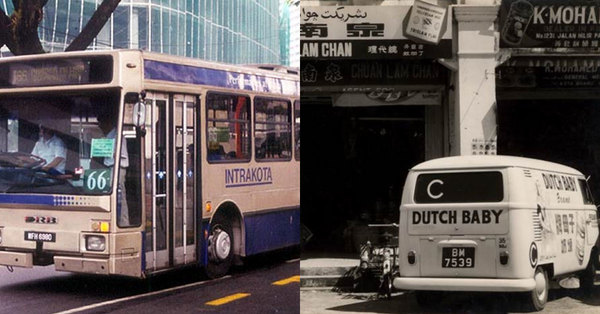Cover image via
Anthony Lui via worldabh
& CLCMSB
Subscribe to our Telegram channel for our latest stories and breaking news.
1. Intrakota > Rapid KL
Prasarana — an entity set up by the Ministry of Finance (MOF) — was incorporated in 1998, but it only became operational in 2002, then group chief executive officer (CEO) Datuk Azmi Abdul Aziz told New Straits Times in 2016.
Two years after the financial crisis in 1998, the government-linked company took over two light rail transit (LRT) lines that were operated by private companies.
In 2004, it took over Intrakota Komposit in order to continue serving commuters in Kuala Lumpur and the Klang Valley.
Prasarana’s bail-out exercise in the late 1990s and early 2000s was how Rapid KL came to be what it is today.
2. Lembaga Letrik Negara (LLN) > Tenaga Nasional (TNB)
Central Electricity Board (CEB) was established in September 1949 before slowly expanding and becoming the owner of 34 power stations, according to Tenaga Nasional’s (TNB) website.
Before CEB’s took over, most generating plants were small and had different methods to generate electricity.
As the company grew bigger, CEB renamed itself to Lembaga Letrik Negara (LLN) — or National Electricity Board of the States of Malaya (NEB) — in June 1965 and it was led by a Malaysian CEO.
Finally in 1990, then premier Tun Dr Mahathir Mohamad proclaimed TNB as the heir and successor to NEB. Since then, TNB has been a private company wholly-owned by the government.
3. Groupon > Fave
How Groupon morphed into Fave mainly revolves around entrepreneur Joel Neoh.
According to The Edge Markets, Neoh founded Groupsmore Malaysia and the company was later acquired by Groupon in 2011.
He was given the position to head Groupon’s Asia Pacific business. However, in 2015, he left the company to start fitness platform KFit.
A year later, KFit acquired Groupon’s Malaysia and Singapore businesses and rebranded as Fave.
Today, Fave is more than a coupon platform as it is also a major mobile payment provider in Malaysia.
4. Dutch Baby > Dutch Lady
Local milk producer Dutch Lady has a long history that dates back all the way to 1954.
As the name suggests, the company’s name can be traced to the Netherlands. In the mid-50s, Friesland (Malaya) Incorporated was established. According to South China Morning Post, the company was set up by Dutch company Friesland Foods.
It started out importing sweetened condensed milk from Holland. By 1963, Pacific Milk Industries (Malaya) was incorporated in Petaling Jaya, Selangor to produce sweetened condensed milk.
In 1975, the company was renamed Dutch Baby Milk Industries (Malaya). Many of its products bore the name ‘Dutch Baby’ on its packaging.
Finally, in 1984, the company changed its name to Dutch Lady. The company was the first Malaysian milk company to be listed on the local stock exchange.
Today, it produces a variety of milk for children and adults.
5. MyTeksi > Grab
MyTeksi’s transition to Grab was a six-year process.
The e-hailing company was founded in 2012 by two Malaysian-born Harvard graduates — Tan Hooi Ling and Anthony Tan. The duo used the USD25,000 (about RM77,000 then) grant from Harvard Business School to kick-start their business.
The company started out as MyTeksi before being renamed a year later to GrabTeksi, reported Digital News Asia.
It was not until 28 January 2016 that the brand was renamed Grab. The company has grown from a humble e-hailing start-up company to become one of Southeast Asia’s most valuable companies.
Today, Grab offers e-hailing, food and package delivery, online payment, and grocery shopping services, among others.
Anthony Tan now holds Singaporean citizenship and Grab has moved its headquarters from Malaysia to Singapore.
6. dahmakan > Pop Meals
Perhaps the brand with the most drastic change on this list, dahmakan rebranding to Pop Meals is not only a rebranding exercise, but also a transformation in its business model.
Co-founded by Jonathan Weins, Jessica Li, and Christian Edelmann in 2014, dahmakan started out as a healthy food cloud kitchen. The former two co-founders were responsible for launching foodpanda in Hong Kong, according to Pop Meals investor Partech.
In November 2020, dahmakan rebranded to Pop Meals. Li told Vulcan Post that the rebrand was necessary because the old name “didn’t capture everything that the product now has to offer: more affordable, more exciting, and popular foods at more locations than when we first started”.
Today, Pop Meals no longer just serves healthy meals, but also comfort food that Malaysians cannot live without. The company is also no longer a cloud kitchen as it also runs physical stores now.
7. Pasar Mini 99 > 99 Speedmart
Do your parents and grandparents always refer to 99 Speedmart as ‘Pasar Mini 99’? Well, they are not technically wrong — if we are still in the 1990s that is.
99 Speedmart came from humble beginnings in Klang, Selangor. In 1987, founder Lee Thiam Wah opened sundry mart Pasar Raya Hiap Hoe in Tepi Sungai, Klang.
By 1992, the first store that bore the name ’99’ opened in Klang Utama. The grocery chain was called Pasar Mini 99 for the most part in the 90s.
It was not until 2000 that Lee decided to rebrand it to 99 Speedmart, changing the classic green and red logo to the bright orange we know today.
There are now nearly 2,000 outlets nationwide.
8. WOBB > Hiredly
WOBB — short for ‘working on bean bags’ — changed its name to Hiredly in July 2021.
In a blog post on its website, Hiredly stated the reason it adopted its new name was because it had to move on from the public perception that WOBB is a job discovery platform that only offers fresh or very junior entry jobs.
The rebrand promises new services on the platform, such as a faster and easier-to-navigate website, an in-house headhunting team to get users hired, and a more personalised job searching experience.
9. Casesbywf > Loucase
Local phone accessories brand Casesbywf was founded by Multimedia University graduate Ain Nurina in 2015. In July 2021, the brand changed its name to Loucase.
In an interview with STERRIFIC in 2019, Ain said the name Casesbywf was actually an abbreviation of Cases By Wallflower. She initially started the business as a wallflower store.
In an Instagram post, Loucase explained the decision to change its name was to make the brand easier to recall.
The new name was derived from the Bahasa Malayu word ‘lukis’ (drawing). The business that boasts almost 120,000 followers on Instagram sells adorable phone cases and it often collaborates with other brands and local artistes to come out with new designs.
10. Bumiputra-Commerce Bank > CIMB
CIMB’s history has a long list of acquisitions, mergers, group restructurings, and renames.
For simplicity’s sake, this section will focus on how Bumiputetra-Commerce Bank was absorbed into CIMB.
CIMB — full name Commerce International Merchant Bankers — was founded by late prime minister Tun Abdul Razak Hussein. It was initially called Pertanian Baring Sanwa Multinational Bank (PBSM) when it was established in 1974.
Over the years, the bank changed hands several times. In a Bank Negara statement in 2000, Bumiputra-Commerce Bank was even once CIMB’s anchor bank.
Bumiputra-Commerce Bank was a popular bank with many branches nationwide in the late 90s and early 00s. Its iconic maroon banners were found in many corners of Malaysia.
However, the tables turned over the years. By 2005, CIMB became the larger bank after some acquisition. It went on to acquire its then sister company Bumiputra-Commerce Bank.
The following year, CIMB Group was launched to serve as a regional universal bank, a move that signified the three-way merger of Bumiputra-Commerce Bank, Commerce International Merchant Bankers, and Southern Bank.
In short, Bumiputra-Commerce Bank lives within CIMB today. To pay homage to its roots, CIMB Group’s consumer banking franchise was moved to Menara Bumiputra-Commerce in 2009.
According to CIMB’s website, the 39-storey building was chosen to “preserve the bank’s historical links” as its predecessors’ headquarters were once located around the area.
11. Arab-Malaysian Banking Group & MBf Finance > AmBank
Many Malaysian banks underwent consolidation in the 2000s and AmBank was no exception.
AmBank was incorporated in August 1975 as a joint venture between Malaysian Industrial Development Finance Berhad, Arab Investments for Asia (Kuwait), and the National Commercial Bank (Saudi Arabia).
It was initially called Arab-Malaysian Development Bank, before being renamed Arab-Malaysian Finance Berhad (AMFB) two years later and Arab-Malaysian Merchant Bank Berhad (AMMB) in 1983.
In 1997, MBf Finance — which once had 153 branches and was a MasterCard leading issuer operating under the product name MBf MasterCard — underwent a crisis. The rumours surrounding the bank’s financial state caused customers to run to the bank to withdraw their savings. Bank Negara had to step in to mediate the situation.
By 2001, AMFB acquired MBf Finance before the group was rebranded to ‘AmBank Group’ with new red corporate colours in the following year. In 2012, the group completed the acquisition of MBF Cards (Malaysia) Sdn Bhd.
12. Malaysian French Bank > Alliance Bank
Malaysian French Bank was incorporated in 1982, but its history started beyond that. Banque de L’Indochine — a bank established in Paris in 1875 and operated in the Asia Pacific — opened its first branch in Malaya on Jalan Pudu, Kuala Lumpur in 1958.
The business grew over the years and by 1975, its name was changed to Banque de L’Indochine et de Suez (Banque Indosuez). Less than a decade later, the Malaysian French Bank was established to assume the banking business of the two local branches of Banque Indosuez.
The Malaysian French Bank changed its name to Multi-Purpose Bank Berhad in 1996. It had around 16 branches at the time.
Under Bank Negara’s directive to consolidate smaller banks, Alliance Bank was born out of the merger of Multi-Purpose Bank and six other institutions.
Banks that were included in the merger were International Bank Malaysia Berhad, Sabah Bank Berhad, Sabah Finance Berhad, Bolton Finance Berhad, Amanah Merchant Bank Berhad, and Bumiputra Merchant Bankers Berhad.
13. Kuala Lumpur Stocks Exchange > Bursa Malaysia
The stock exchange of Malaysia was not always called Bursa Malaysia.
Its history can be traced all the way back to 1930 when the first formal securities business organisation was established in Malaysia. It was called the Singapore Stockbrokers’ Association.
Seven years later, it was re-registered as the Malayan Stockbrokers’ Association before the Stock Exchange of Malaysia was established in 1964.
After the secession of Singapore from Malaysia, the common stock exchange continued to function under the name Stock Exchange of Malaysia and Singapore (SEMS). By 1973, the Kuala Lumpur Stock Exchange Berhad was born. The KLSE Composite Index was launched in 1986.
In 2004, Kuala Lumpur Stock Exchange changed its name to Bursa Malaysia. According to its website, the purpose of the rename was “to enhance competitive position and to respond to global trends in the exchange sector by making the exchange more customer-driven and market-oriented”.
14. Empat Nombor Ekor > Magnum4D
Do your grandparents, uncles, aunties, and parents always refer to the lottery as ‘Empat Nombor Ekor’?
We are just too young to get it because between 1968 and 1977, Magnum Corporation Sdn Bhd’s four-digit lottery business was called Empat Nombor Ekor Sdn Bhd.
It was the first private company to be granted a licence to promote, operate, and manage four-digit lottery betting in Malaysia.
On 2 June 1977, the company changed its name to Magnum Corporation Berhad. However, in 2008, the group turned its gaming business into a subsidiary through a privatisation exercise. It assumed its current name following the group restructuring.
In September 2009, the company introduced the ‘Magnum 4D Jackpot’ game.



